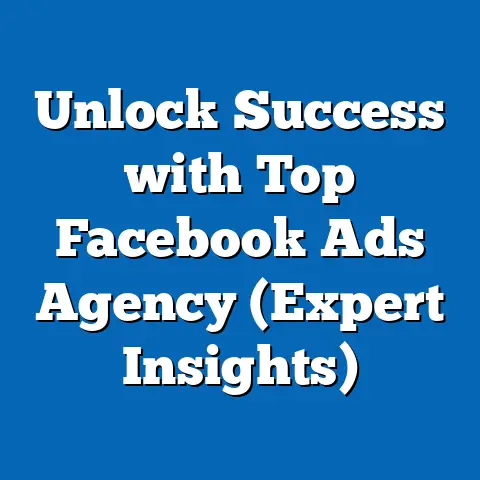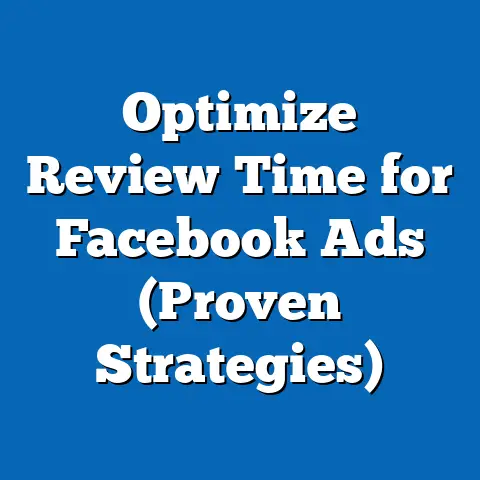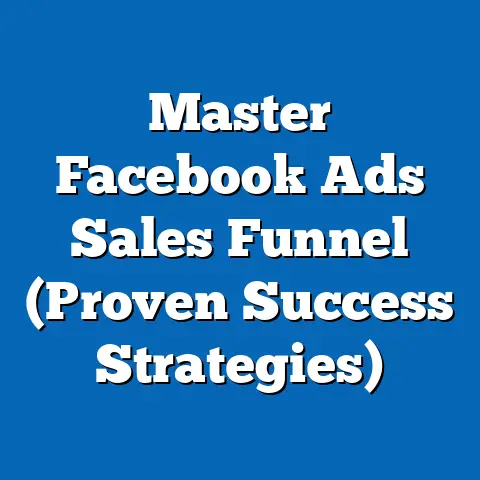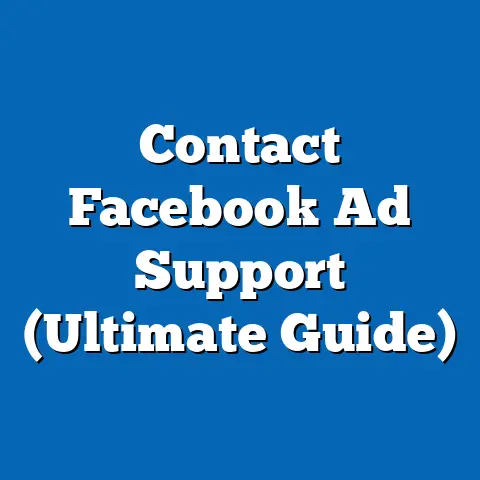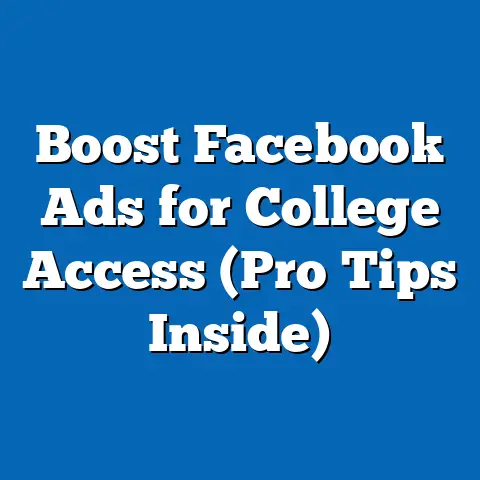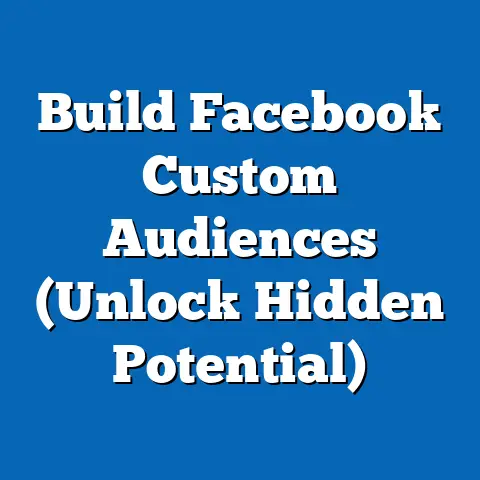Boost CTR: Facebook Ads Benchmark Secrets (Expert Insights)
Have you ever felt like your Facebook ads are shouting into a void? All that time, effort, and money – and barely a click to show for it? I get it. I’ve been there. I remember working with a small, family-owned bakery in my early days as a digital marketer. They were struggling to compete with the larger chains in town. We decided to give Facebook Ads a try, but initially, the results were…underwhelming. Their CTR was abysmal – hovering around 0.3%, which, frankly, was a disaster. They were ready to throw in the towel, convinced that Facebook Ads just didn’t work for them.
But I wasn’t ready to give up. We dug deep, analyzed their audience, tweaked their ad copy, and experimented with different visuals. We even started running A/B tests on our call-to-actions. And guess what? Within a month, their CTR skyrocketed to 1.2%! This wasn’t just a marginal improvement; it was a game-changer. Their website traffic doubled, their in-store visits increased, and their sales went through the roof. They practically had to hire extra staff to keep up with the demand!
Think of CTR as the pulse of your Facebook ad campaign. It’s the metric that tells you whether your message is resonating with your audience or falling flat. A high CTR means your ad is captivating, relevant, and compelling. A low CTR, on the other hand, signals that something needs to change.
In this article, I’ll be peeling back the layers of Facebook Ads, revealing the benchmark secrets that can transform your campaigns from underperformers to click-generating machines. We’ll explore industry benchmarks, delve into the psychology behind clicks, and provide a step-by-step guide to crafting high-CTR ads. Get ready to take your Facebook Ads game to the next level!
1: Understanding CTR in the Context of Facebook Ads
Let’s start with the basics. What exactly is CTR, and why should you care?
What is Click-Through Rate (CTR)?
Click-Through Rate (CTR) is the percentage of people who see your ad and click on it. It’s calculated by dividing the number of clicks your ad receives by the number of times it’s shown (impressions), then multiplying by 100.
- Formula: CTR = (Total Clicks / Total Impressions) * 100
For example, if your ad receives 100 clicks after being shown 10,000 times, your CTR would be 1%.
- CTR = (100 / 10,000) * 100 = 1%
Why is CTR Important for Facebook Ads?
CTR is a critical metric for several reasons:
- Relevance Score: Facebook uses CTR as one of the factors to determine your ad’s relevance score. A higher relevance score can lead to lower ad costs and better ad placement.
- Ad Performance: A high CTR indicates that your ad is engaging and relevant to your target audience. It shows that your message is resonating with people and that they’re interested in what you have to offer.
- Quality Score: Similar to Google Ads, Facebook Ads has a “quality score” which is influenced by CTR. A higher quality score can lead to lower costs per click (CPC) and better ad delivery.
- Cost Efficiency: A higher CTR means you’re getting more clicks for your money. This can significantly improve your return on investment (ROI) on your advertising spend.
- Website Traffic: A higher CTR drives more traffic to your website or landing page. This can lead to more conversions, sales, and ultimately, more revenue.
Average CTR for Facebook Ads: The Benchmark
While CTR varies significantly across industries and ad types, understanding the average CTR can provide a useful benchmark. According to recent studies, the average CTR for Facebook Ads across all industries is around 0.90%. However, this is just an average. Some industries, like apparel and retail, tend to have higher CTRs, while others, like finance and insurance, often have lower CTRs.
It’s important to remember that these are just averages. Your goal should always be to improve your own CTR, regardless of industry benchmarks.
Factors Influencing CTR:
Several factors can influence your Facebook Ad CTR, including:
- Ad Copy: The words you use in your ad can have a significant impact on whether people click. Compelling, relevant, and persuasive ad copy is essential.
- Visuals: Images and videos are powerful tools for capturing attention and driving clicks. High-quality, visually appealing visuals are crucial.
- Audience Targeting: Targeting the right audience is essential for ensuring that your ad is relevant to the people who see it.
- Ad Placement: The placement of your ad (e.g., Facebook News Feed, Instagram Feed, Audience Network) can affect its visibility and click-through rate.
- Call-to-Action (CTA): A clear and compelling CTA tells people what you want them to do and encourages them to click.
- Ad Relevance: Facebook rewards ads that are relevant to the user. Ads with a high relevance score (based on positive and negative feedback) will generally have higher CTRs and lower costs.
- Mobile Optimization: With the majority of Facebook users accessing the platform via mobile devices, ensuring your ads are optimized for mobile viewing is crucial. This includes using mobile-friendly landing pages and optimizing image sizes for smaller screens.
- Ad Fatigue: Over time, users may become less responsive to the same ad, leading to a decline in CTR. Regularly refreshing your ad creative can help combat ad fatigue.
- Time of Day/Week: User behavior can vary based on the time of day or day of the week. Analyzing when your audience is most active and adjusting your ad scheduling accordingly can improve CTR.
- Seasonality: Consumer behavior shifts during different seasons and holidays. Tailoring your ad messaging and creative to align with these seasonal trends can boost engagement and CTR.
Takeaway:
Understanding CTR is the first step towards improving your Facebook Ads performance. By knowing how CTR is calculated, why it’s important, and what factors influence it, you can start to optimize your campaigns for higher click-through rates.
Next Steps:
- Review your current Facebook Ads campaigns and identify those with low CTRs.
- Analyze the factors that may be contributing to low CTRs, such as ad copy, visuals, and audience targeting.
- Start brainstorming ways to improve these factors and boost your CTR.
2: Industry Benchmarks and Variability
Okay, now that we have a handle on what CTR is and why it matters, let’s talk about benchmarks. What’s considered a “good” CTR? And how does it vary across different industries?
The Reality of Industry Benchmarks:
As I mentioned earlier, the average CTR for Facebook Ads across all industries is around 0.90%. However, this number can be misleading. The truth is, CTR varies significantly depending on the industry you’re in.
Here’s a breakdown of average CTRs by industry, based on recent data from WordStream and other sources:
- Apparel: 1.21%
- Retail: 1.19%
- Beauty: 1.16%
- Finance: 0.78%
- Healthcare: 0.77%
- Technology: 0.75%
As you can see, some industries consistently outperform others. This is due to several factors, including:
- Product Appeal: Some products are simply more visually appealing and easier to market than others. Apparel and beauty products, for example, often lend themselves well to eye-catching visuals.
- Target Audience: The demographics and interests of your target audience can also affect CTR. Certain demographics may be more likely to click on ads than others.
- Competition: Highly competitive industries may have lower CTRs due to increased ad clutter.
How Industry Trends Affect CTR Benchmarks:
Industry trends can also significantly impact CTR benchmarks. For example, during the COVID-19 pandemic, many industries saw a surge in online advertising, leading to increased competition and potentially lower CTRs.
Conversely, emerging industries or those experiencing rapid growth may see higher CTRs due to increased consumer interest and less competition.
Case Studies: Learning from the Best
One of the best ways to understand how to achieve above-average CTRs is to study successful campaigns. Let’s take a look at a few examples:
- Dollar Shave Club: Dollar Shave Club built a wildly successful brand through clever and humorous video ads on Facebook. Their ads were highly shareable and generated a lot of buzz, leading to a high CTR and low cost per acquisition. The key here was their bold, unconventional approach and their focus on entertaining their audience.
- Warby Parker: Warby Parker disrupted the eyewear industry with its stylish and affordable glasses. Their Facebook Ads were visually appealing and showcased their products in a compelling way. They also offered a “try-on” program, which allowed customers to order glasses online and try them on at home before committing to a purchase. This innovative approach helped them stand out from the competition and drive a high CTR. The key was their focus on customer experience and their willingness to offer a unique value proposition.
- Airbnb: Airbnb has mastered the art of storytelling in their Facebook Ads. They showcase beautiful homes and destinations around the world, inspiring people to travel and explore new cultures. Their ads are highly aspirational and tap into people’s desire for adventure. This emotional connection helps them drive a high CTR. The key was their focus on emotional storytelling and their ability to connect with their audience on a personal level.
- Sephora: Sephora consistently achieves high CTRs by targeting beauty enthusiasts with personalized product recommendations and exclusive offers. Their ads are visually appealing and showcase their wide range of beauty products. They also use retargeting to reach people who have previously visited their website or engaged with their content. The key was their focus on personalization and their ability to deliver the right message to the right person at the right time.
Analyzing Successful Campaigns:
What do these successful campaigns have in common?
- Compelling Visuals: They all use high-quality, visually appealing images and videos.
- Clear Messaging: They communicate their value proposition clearly and concisely.
- Targeted Audience: They target the right audience with relevant ads.
- Strong CTA: They include a clear and compelling call-to-action.
- Unique Value Proposition: They offer something unique and valuable that sets them apart from the competition.
Takeaway:
Industry benchmarks can provide a useful starting point, but it’s important to remember that they’re just averages. Your goal should be to outperform your industry benchmarks by creating compelling, relevant, and targeted ads. By studying successful campaigns and analyzing their key elements, you can learn valuable lessons and apply them to your own Facebook Ads strategy.
Next Steps:
- Research the average CTR for your industry.
- Analyze your own Facebook Ads campaigns and compare your CTRs to industry benchmarks.
- Identify areas where you can improve your ad copy, visuals, and audience targeting.
- Study successful campaigns in your industry and identify the key elements that contribute to their high CTRs.
3: The Psychology Behind Clicks
Let’s get into the mind of your audience. Why do people click on some ads and ignore others? Understanding the psychology behind clicks is crucial for crafting ads that grab attention and drive results.
The Power of Curiosity:
One of the most powerful psychological triggers is curiosity. People are naturally curious and want to learn more about things that pique their interest. You can leverage curiosity in your Facebook Ads by:
- Asking Questions: Pose a question that your target audience will want to answer.
- Creating Intrigue: Tease a product or service without revealing all the details.
- Using “Curiosity Gap” Headlines: Create headlines that suggest there’s something important the reader is missing out on.
For example, an ad for a new fitness program might ask: “Are you making these 3 common workout mistakes?” This headline creates curiosity by suggesting that the reader may be unknowingly sabotaging their fitness efforts.
The Urgency Factor:
Urgency is another powerful motivator. People are more likely to take action when they feel like they might miss out on something. You can create a sense of urgency in your Facebook Ads by:
- Using Time-Limited Offers: Offer discounts or promotions that expire within a certain timeframe.
- Highlighting Limited Availability: Emphasize that your product or service is in limited supply.
- Using Words Like “Now,” “Today,” and “Don’t Miss Out”: These words create a sense of urgency and encourage immediate action.
For example, an ad for a flash sale might say: “Don’t miss out! 50% off all items for 24 hours only!” This headline creates urgency by highlighting the limited-time nature of the offer.
The Emotional Connection:
People are emotional creatures, and their emotions play a significant role in their purchasing decisions. You can tap into people’s emotions in your Facebook Ads by:
- Telling Stories: Share stories that resonate with your target audience and evoke emotions like joy, hope, or inspiration.
- Using Emotional Language: Use words that evoke emotions and create a connection with your audience.
- Highlighting the Benefits, Not Just the Features: Focus on how your product or service will make people feel, rather than just listing its features.
For example, an ad for a travel agency might show a family enjoying a vacation on a tropical beach. This visual evokes emotions of happiness, relaxation, and adventure, making people more likely to book a trip.
The Role of Storytelling:
Storytelling is a powerful tool for engaging your audience and driving clicks. When you tell a story, you’re not just selling a product or service; you’re creating a connection with your audience on a personal level.
Here are a few tips for using storytelling in your Facebook Ads:
- Focus on the Customer’s Journey: Tell a story about how your product or service helped a customer overcome a challenge or achieve a goal.
- Use Vivid Language: Paint a picture with your words and bring your story to life.
- Make it Relatable: Tell a story that your target audience can relate to and connect with.
Expert Insights on Effective Messaging:
I reached out to a friend of mine, Dr. Sarah Jones, a marketing psychologist with over 15 years of experience, for her insights on effective messaging. Here’s what she had to say:
“When crafting your Facebook Ads, remember that you’re not just selling a product or service; you’re selling an emotion, a feeling, a transformation. People buy based on emotions, then justify their decisions with logic. So, tap into their emotions, address their pain points, and show them how your product or service can make their lives better.”
Dr. Jones also emphasized the importance of understanding your target audience’s values and beliefs. “What are their aspirations? What are their fears? What do they care about? The more you understand your audience, the better you can craft messages that resonate with them.”
Takeaway:
Understanding the psychology behind clicks is essential for crafting Facebook Ads that grab attention and drive results. By leveraging curiosity, urgency, emotional connection, and storytelling, you can create ads that resonate with your target audience and encourage them to click.
Next Steps:
How do you actually create Facebook Ads that get people clicking? I’m going to break it down into several key elements:Compelling Headlines: The First Impression
Your headline is the first thing people see when they encounter your ad. It’s your chance to grab their attention and make them want to learn more. Here are some tips for crafting attention-grabbing headlines:
- Keep it Short and Sweet: Aim for headlines that are 25-35 characters long.
- Use Strong Verbs: Use action verbs that create a sense of urgency or excitement.
- Highlight the Benefit: Focus on the main benefit that your product or service offers.
- Ask a Question: Pose a question that your target audience will want to answer.
- Use Numbers and Statistics: Numbers and statistics can add credibility and make your headline more eye-catching.
- Create a Sense of Scarcity: Use words like “Limited Time,” “While Supplies Last,” or “Exclusive Offer” to create a sense of urgency.
Here are some examples of compelling headlines:
- “Get 50% Off All Items Today Only!”
- “Discover the Secret to a Flatter Stomach”
- “Are You Making These 3 Common Mistakes?”
- “The Ultimate Guide to Facebook Ads in 2024”
- “Free Ebook: Boost Your Sales by 20% in 30 Days”
Visual Elements: Capturing Attention
Visuals are another crucial element of high-CTR Facebook Ads. People are visual creatures, and they’re more likely to pay attention to ads that include eye-catching images or videos.
Here are some tips for using visuals effectively:
- Use High-Quality Images and Videos: Make sure your visuals are clear, sharp, and visually appealing.
- Showcase Your Product or Service: Use visuals that showcase your product or service in a compelling way.
- Use People in Your Visuals: People are more likely to connect with visuals that feature other people.
- Use Bright Colors: Bright colors can help your ad stand out from the crowd.
- Use Movement: Videos and animated GIFs can be very effective at capturing attention.
- Consider Your Brand: Your visuals should align with your brand’s overall aesthetic and messaging.
- Use A/B Testing: Test different visuals to see which ones perform best with your target audience.
Ad Copy Tips: Persuading and Converting
Your ad copy is your opportunity to persuade people to click on your ad and take action. Here are some tips for writing persuasive ad copy:
- Know Your Audience: Understand their needs, wants, and pain points.
- Highlight the Benefit: Focus on how your product or service will make their lives better.
- Use Clear and Concise Language: Avoid jargon and technical terms.
- Use a Strong Call-to-Action (CTA): Tell people what you want them to do (e.g., “Learn More,” “Shop Now,” “Sign Up”).
- Create a Sense of Urgency: Use words like “Now,” “Today,” and “Don’t Miss Out” to encourage immediate action.
- Use Social Proof: Include testimonials or reviews to build trust and credibility.
- Address Objections: Anticipate and address any potential objections that your target audience might have.
- Use Storytelling: Share stories that resonate with your target audience and evoke emotions.
- Keep it Mobile-Friendly: Ensure your ad copy is easy to read on mobile devices.
- Test Different Versions: A/B test different versions of your ad copy to see what performs best.
The Importance of a Clear Call-to-Action (CTA):
Your call-to-action (CTA) is the final nudge that encourages people to click on your ad. It should be clear, concise, and compelling. Here are some examples of effective CTAs:
- “Learn More”
- “Shop Now”
- “Sign Up”
- “Download Now”
- “Get Started”
- “Claim Your Offer”
- “Book Now”
- “Contact Us”
Audience Targeting: Reaching the Right People
Targeting the right audience is essential for maximizing your CTR. If you’re showing your ad to people who aren’t interested in your product or service, they’re unlikely to click on it.
Facebook offers a wide range of targeting options, including:
- Demographics: Age, gender, location, education, relationship status, etc.
- Interests: Hobbies, interests, and activities.
- Behaviors: Purchasing behavior, travel habits, device usage, etc.
- Custom Audiences: Upload your own customer data (e.g., email addresses, phone numbers) to create custom audiences.
- Lookalike Audiences: Create audiences that are similar to your existing customers.
Tips for Effective Audience Targeting:
- Start with a Broad Audience: Begin with a broad audience and then narrow it down based on performance data.
- Use Layered Targeting: Combine multiple targeting options to reach a more specific audience.
- Test Different Audiences: A/B test different audiences to see which ones perform best.
- Use Lookalike Audiences: Create lookalike audiences based on your best-performing custom audiences.
- Exclude Unqualified Leads: Exclude people who are unlikely to be interested in your product or service.
- Monitor Your Audience Performance: Regularly monitor your audience performance and make adjustments as needed.
Using Facebook’s Audience Insights Tool Effectively:
Facebook’s Audience Insights tool can provide valuable data about your target audience, including their demographics, interests, behaviors, and purchasing habits. You can use this data to refine your targeting and create more relevant ads.
Takeaway:
Crafting high-CTR Facebook Ads requires a combination of compelling headlines, eye-catching visuals, persuasive ad copy, and effective audience targeting. By focusing on these key elements, you can create ads that grab attention, resonate with your target audience, and drive clicks.
Next Steps:
- Brainstorm compelling headlines for your Facebook Ads.
- Gather high-quality images and videos that showcase your product or service.
- Write persuasive ad copy that highlights the benefits of your product or service.
- Refine your audience targeting to reach the right people.
- Use Facebook’s Audience Insights tool to gather data about your target audience.
5: Testing and Optimizing for Higher CTR
You’ve crafted some amazing ads. Now what? The key to sustained success with Facebook Ads is continuous testing and optimization.
The Importance of A/B Testing:
A/B testing (also known as split testing) is the process of comparing two versions of an ad to see which one performs better. It’s a powerful tool for identifying the elements that resonate most with your target audience and driving higher CTRs.
Step-by-Step Guide to Setting Up A/B Tests:
- Choose a Variable to Test: Select one element of your ad that you want to test (e.g., headline, image, ad copy, CTA).
- Create Two Versions of Your Ad: Create two versions of your ad, each with a different variation of the variable you’re testing.
- Set Up Your A/B Test: Use Facebook’s A/B testing tool to create your test.
- Define Your Test Parameters: Set your budget, duration, and target audience.
- Run Your Test: Let your test run for a sufficient amount of time (usually at least a week) to gather enough data.
- Analyze Your Results: Use Facebook’s reporting tools to analyze your results and identify the winning version of your ad.
- Implement the Winning Version: Implement the winning version of your ad and continue testing other variables.
Testing Different Elements of an Ad:
Here are some examples of elements you can test in your Facebook Ads:
- Headlines: Test different headlines to see which ones grab the most attention.
- Images: Test different images to see which ones resonate best with your target audience.
- Ad Copy: Test different ad copy to see which one is most persuasive.
- CTAs: Test different CTAs to see which one drives the most clicks.
- Audiences: Test different audiences to see which ones are most responsive to your ads.
- Placements: Test different placements (e.g., Facebook News Feed, Instagram Feed, Audience Network) to see which ones perform best.
Expert Recommendations on Analyzing Test Results:
I spoke with another friend, Mark Thompson, a seasoned Facebook Ads expert, about how to analyze test results effectively. Here’s his advice:
“Don’t just look at the CTR. Look at the entire funnel. How are your ads performing in terms of conversions, leads, and sales? Sometimes, an ad with a slightly lower CTR can actually generate more revenue if it’s more effective at converting leads into customers. Also, make sure you’re testing one variable at a time. If you change too many things at once, you won’t know which change caused the improvement (or decline) in performance.”
Mark also emphasized the importance of statistical significance. “Make sure your test results are statistically significant before making any major decisions. You can use a statistical significance calculator to determine whether your results are reliable.”
Examples of Companies Improving CTR Through Testing:
- HubSpot: HubSpot, a leading marketing automation platform, uses A/B testing extensively to optimize its Facebook Ads. They’ve tested everything from headlines to images to CTAs, and they’ve seen significant improvements in their CTR and conversion rates as a result.
- Neil Patel Digital: Neil Patel Digital, a digital marketing agency, uses A/B testing to optimize its clients’ Facebook Ads. They’ve helped their clients achieve significant improvements in their CTR, conversion rates, and ROI.
- WordStream: WordStream, a provider of online advertising tools, uses A/B testing to optimize its own Facebook Ads. They’ve shared numerous case studies on their blog, demonstrating how they’ve improved their CTR and conversion rates through testing.
Takeaway:
Testing and optimizing your Facebook Ads is an ongoing process. By using A/B testing to identify the elements that resonate most with your target audience, you can continuously improve your CTR, conversion rates, and ROI.
Next Steps:
The key takeaways from this article are:
- CTR is a critical metric for Facebook Ads success.
- Industry benchmarks can provide a useful starting point, but it’s important to outperform them.
- Understanding the psychology behind clicks is essential for crafting ads that grab attention.
- Crafting high-CTR ads requires a combination of compelling headlines, eye-catching visuals, persuasive ad copy, and effective audience targeting.
- Testing and optimizing your ads is an ongoing process.
I hope this guide has provided you with the knowledge and tools you need to boost your CTR and achieve your Facebook Ads goals. Remember, the world of digital advertising is constantly evolving, so it’s crucial to stay up-to-date on the latest trends and best practices. Keep learning, keep testing, and keep optimizing, and you’ll be well on your way to Facebook Ads success!
Now, go out there and create some amazing ads that get people clicking! I’m excited to see what you accomplish.

